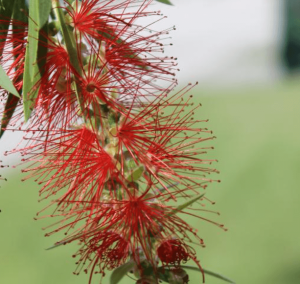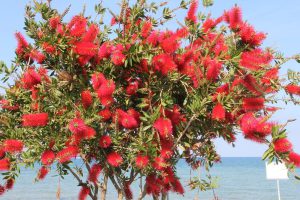 Bottlebrush: Florida Friendly or Foe?
Bottlebrush: Florida Friendly or Foe?
Bottlebrush is a common plant in the landscapes of Florida; you may know it for its showy red blooms that, resembling bottlebrushes, coined the tree’s name. Although it thrives in both south and central Florida, bottlebrush is native to Australia, which is also home of the extremely invasive Australian Pine and Melaleuca tree. Recently, the UF/IFAS Assessment of Non-Native Plants in Florida’s Natural Areas deemed one species of bottlebrush to be a high invasion risk – so, is bottlebrush a Florida-Friendly plant or a Florida foe?

Weeping vs. Red Bottlebrush
Before a verdict can be made, a deeper understanding of this tree is needed. There are two main species of bottlebrush used in Florida: weeping bottlebrush and red bottlebrush (scientific names Melaleuca viminalis and Melaleuca citrinus, respectively). To distinguish the two, look at their branches; weeping bottlebrush has a very exaggerated droop in its canopy, while red bottlebrush branches are more erect. Although the intensity of the droop may not be obvious when looking at just one specimen, comparing the two side-by-side makes the distinction easier.
Growing Bottlebrush Safely
Still, the question remains: is bottlebrush safe to grow in Florida? The answer – yes! Specifically, red bottlebrush is entirely safe and recommended as a Florida-Friendly landscape plant. However, weeping bottlebrush should be avoided due to its documented risk of invasiveness. Unless grown indoors or in an enclosed greenhouse, weeping bottlebrush plants already in the landscape should be monitored for spread or, if located near a natural area, removed. If you have a weeping bottlebrush in your landscape, keep an eye on the UF/IFAS Assessment; this species will be re-evaluated soon for an updated invasiveness conclusion, meaning it could be deemed as invasive.
UPDATE (6/15/2023) After further research, it was found that weeping bottlebrush is an invasion risk in SOUTH FLORIDA ONLY. If you are planning to plant this tree or have one in your landscape, and you are located in CENTRAL or NORTH Florida, the tree will post little to no risk. However, if you are in SOUTH Florida, please use your discretion while planting or maintaining a weeping bottlebrush. Contact your local Extension office for area-specific recommendations.
Resources:
https://assessment.ifas.ufl.edu/assessments/callistemon-citrinus/
https://assessment.ifas.ufl.edu/assessments/melaleuca-viminalis/
https://edis.ifas.ufl.edu/publication/ST110
https://edis.ifas.ufl.edu/publication/ST111
Note: unless otherwise mentioned, images are property of UF/IFAS.
HELP PROVIDE BLOG IMPACTS BY COMPLETING THIS SURVEY (bit.ly/47a26UN)
THANK YOU!
 5
5


